Sickleholme Nature Notes
I delayed the production of the January notes for a few days since there had been a significant reduction in the number of reported wildlife sightings. This due mainly to the month’s weather and the related restrictions on our golf. Several members did, however, comment on the Brown Hares that can regularly be seen around the machinery sheds or along towards the 12th tee. The species is somewhat more welcome on golf courses than are Rabbits, since they do not excavate burrows or disturb the bunkers. A walk along the railway hedge evidenced early bird song, with Coal Tits, Great Tits, Robins and Wrens quite vocal. Our early flora, however, seemed restricted to a few Daisies that managed to flower and the attractive Hazel catkins (see photo).
Space then, for a few “good news” snippets. Following the approval of the club’s Environmental Policy, the group of members who first sponsored the idea then focused on the ecological aspects of the policy and have now put forward proposals covering action plans and further ideas. These are a mix of suggestions which we feel the club could adopt and administer as well as surveys/small projects that could be undertaken by individual members, with support from locally based specialists where needed. A response from the club is now eagerly awaited.
The club website announced that Marie Athorn has taken up a position with the RSPB, funded by the R & A, that it is planned will advise a number of golf clubs on the management of wildlife species and which will promote best practice in that respect. That has given me much satisfaction since I served on the RSPB Council for seven years and regularly promoted closer working with county bird clubs, local natural history societies and golf clubs. It was a subject that I later returned to when I was granted a guest editorial in the well-respected journal, British Birds, and so I am delighted that Sickleholme features in the announcement of this excellent new initiative.
An article in the Warwickshire Wildlife Trust magazine majored on the same theme and advised that a number of that county’s golf clubs have formed a working group to promote their conservation activities and objectives and to share experiences.
The whole concept, therefore, seems to be gathering national momentum in a way that can only help. All in all, I have to think that this wider recognition of golf courses as providing valuable wildlife populations and habitats can only benefit the clubs, as well as our flora and fauna.
Bryan Barnacle


